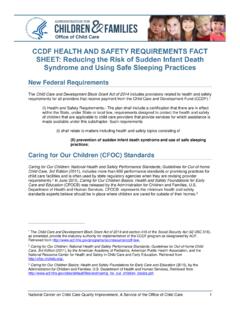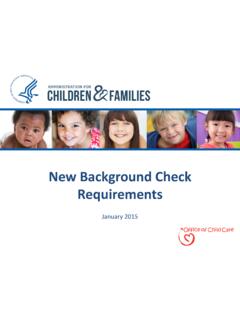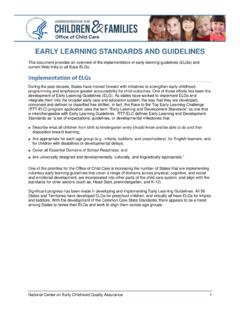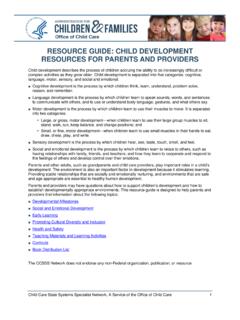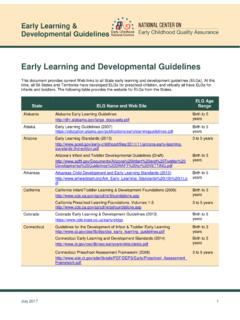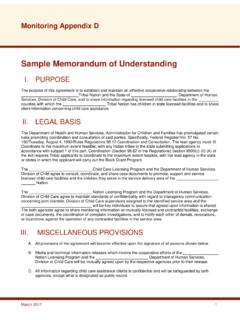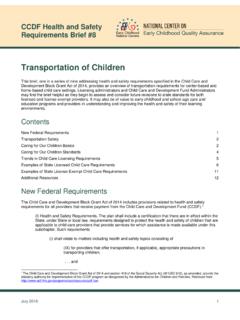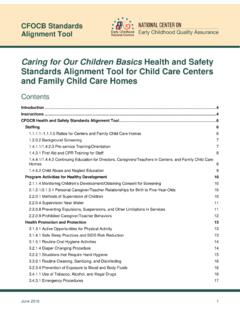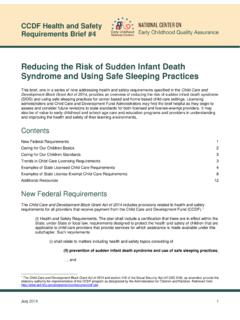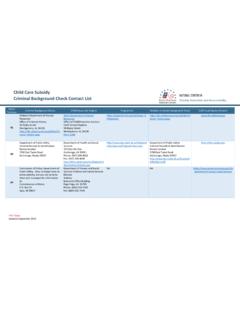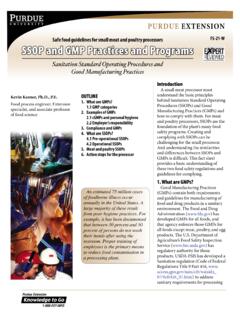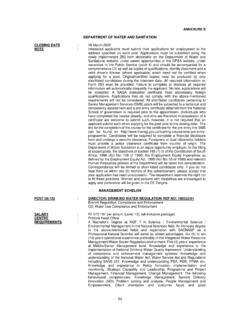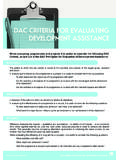Transcription of CCDF Health and Safety Requirements Brief #7 Handling ...
1 CCDF Health and Safety Requirements Brief #7 Handling , Storing, and Disposing of Hazardous Materials and Biological Contaminants This Brief , one in a series of nine addressing Health and Safety Requirements specified in the Child Care and Development Block Grant Act of 2014, provides an overview of Handling and storing hazardous materials for center-based and home-based child care settings. Licensing administrators and Child Care and Development Fund Administrators may find the Brief helpful as they begin to assess and consider future revisions to state standards for both licensed and license-exempt providers. It may also be of value to early childhood and school-age care and education programs and providers in understanding and improving the Health and Safety of their learning environments.
2 Contents New Federal Requirements 1 Hazardous Materials in Child Care 2 Caring for Our Children Basics 3 Caring for Our Children Standards 5 Trends in Child Care Licensing Requirements 7 Examples of State Licensed Child Care Requirements 7 Examples of State License-Exempt Child Care Requirements 12 Additional Resources 13 New Federal Requirements The Child Care and Development Block Grant Act of 2014 includes provisions related to Health and Safety Requirements for all providers that receive payment from the Child Care and Development Fund (CCDF).1 (I) Health and Safety Requirements . The plan shall include a certification that there are in effect within the State, under State or local law, Requirements designed to protect the Health and Safety of children that are applicable to child care providers that provide services for which assistance is made available under this subchapter.
3 Such Requirements (i) shall relate to matters including Health and Safety topics consisting of (VIII) the Handling and storage of hazardous materials and the appropriate disposal of biocontaminants .. 1 The Child Care and Development Block Grant Act of 2014 and section 418 of the Social Security Act (42 USC 618), as amended, provide the statutory authority for implementation of the CCDF program as designated by the Administration for Children and Families. Retrieved from July 2016 1 Hazardous Materials and Biological Contaminants (XI) minimum Health and Safety training, to be completed pre-service or during an orientation period in addition to ongoing training, appropriate to the provider setting involved that addresses each of the Requirements relating to matters described in subclauses (I) through (X); Hazardous Materials in Child Care Children are much more vulnerable than adults to exposures of hazardous materials because their bodies are developing; they eat more, drink more, and breathe more in proportion to their body size.
4 And their behavior, such as crawling and hand-to-mouth activity, can expose them more to chemicals and infectious Many types of infectious germs may be contained in human waste (urine, feces) and body fluids (saliva, nasal discharge, tissue and injury discharges, eye discharges, blood, and vomit).3 There are more than two million human poison exposures reported to poison centers every year. Children younger than 6 years account for more than half of those potential poisonings. The substances most commonly involved in children s poison exposures are cosmetics and personal care products, cleaning substances, and Exposure to a toxic substance can occur if certain chemicals are inhaled or ingested or contact the skin. The phone number 1-800-222-1222, the universal number for all 55 Poison control Centers in the United States, should be posted in readily visible locations near telephones and added to teachers cell phones in the event an accidental poisoning occurs.
5 Carbon monoxide is a deadly, colorless, odorless, poisonous gas; you cannot see, taste, or smell it. Young children are especially vulnerable to the effects of carbon monoxide because of their smaller bodies. Children process carbon monoxide differently than adults, may be more severely affected by it, and may show signs of poisoning sooner. In 2009, poison control centers reported more than 3,551 cases of carbon monoxide exposure in children 19 years and Carbon monoxide is produced by the incomplete burning of various fuels, including coal, wood, charcoal, oil, kerosene, propane, and natural gas. Using a carbon monoxide detector is the only way to identify whether this substance is at a dangerous Lead is a neurotoxin.
6 Even at low levels of exposure, lead can cause reduction in a child s IQ and attention span, and result in reading and learning disabilities, hyperactivity, and behavioral difficulties. Lead poisoning has no cure. These effects cannot be reversed once the damage is done, affecting a child s ability to learn, succeed in school, and function later in life. Other symptoms of low levels of lead in a child s body are subtle behavioral changes, irritability, low appetite, weight loss, sleep disturbances, and shortened attention , 8 The sources of lead can be any of the following: water impacted by pipes that are made of lead or copper, soil, flaking paint chips, and toys. 2 Environmental Protection Agency. (2015). Human Health risk assessment [Web page].
7 Retrieved from 3 American Academy of Pediatrics, American Public Health Association, & National Resource Center for Health and Safety in Child Care and Early Education. (2011). Caring for our children: National Health and Safety performance standards; guidelines for early care and education programs, 3rd edition. Standard : Use and storage of toxic substances. Retrieved from 4 See note 3. 5 Safe Kids Worldwide. ( ). Carbon monoxide Safety tips [Web page]. Retrieved from 6 American Academy of Pediatrics, American Public Health Association, & National Resource Center for Health and Safety in Child Care and Early Education. (2011). Caring for our children: National Health and Safety performance standards; guidelines for early care and education programs, 3rd edition.
8 Standard : Carbon monoxide detectors. Retrieved from 7 Advisory Committee on Childhood Lead Poisoning Prevention, Centers for Disease control and Prevention. (2012). Low level lead exposure harms children: A renewed call for primary prevention. Retrieved from 8 Environmental Protection Agency. (2011). The lead-safe certified guide to renovate right. Retrieved from July 2016 2 Hazardous Materials and Biological Contaminants Caring for Our Children Basics Released in 2015 by the Administration for Children and Families (ACF), Caring for Our Children Basics: Health and Safety Foundations for Early Care and Education (CFOCB) represents the minimum Health and Safety standards experts believe should be in place where children are cared for outside their CFOCB seeks to reduce conflicts and redundancies found in program standards linked to multiple funding streams.
9 Though voluntary, ACF hopes CFOCB will be a helpful resource for States and other entities as they work to improve Health and Safety standards in licensing and quality rating and improvement systems. T he following standards from CFOCB address the Handling and storage of hazardous materials and the appropriate disposal of biocontaminants in early care and education settings. Situations that Require Hand Hygiene10 All staff, volunteers, and children should abide by the following procedures for hand washing, as defined by the Centers for Disease control and Prevention (CDC): a. Upon arrival for the day, after breaks, or when moving from one group to another. b. Before and after: Preparing food or beverages; Eating, Handling food, or feeding a child; Brushing or helping a child brush teeth; Giving medication or applying a medical ointment or cream in which a break in the skin ( , sores, cuts, or scrapes) may be encountered; Playing in water (including swimming) that is used by more than one person; and Diapering.
10 C. After: Using the toilet or helping a child use a toilet; Handling bodily fluid (mucus, blood, vomit); Handling animals or cleaning up animal waste; Playing in sand, on wooden play sets, and outdoors; and Cleaning or Handling the garbage. Situa tio ns or times t hat c hil dren and staff should perform hand hygiene should be posted in all food preparation, diapering, and toileting areas. Prevention of Exposure to Blood and Body Fluids Early care and education programs should adopt the use of Standard Precautions, developed by the Centers for Disease control and Prevention (CDC), to handle potential exposure to blood and other potentially infectious fluids. Caregivers and teachers are required to be educated regarding Standard 9 Administration for Children and Families, Department of Health and Human Services.
